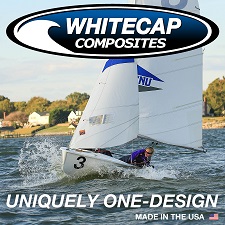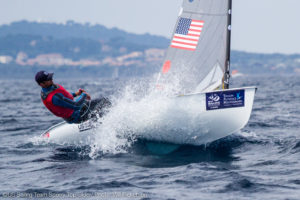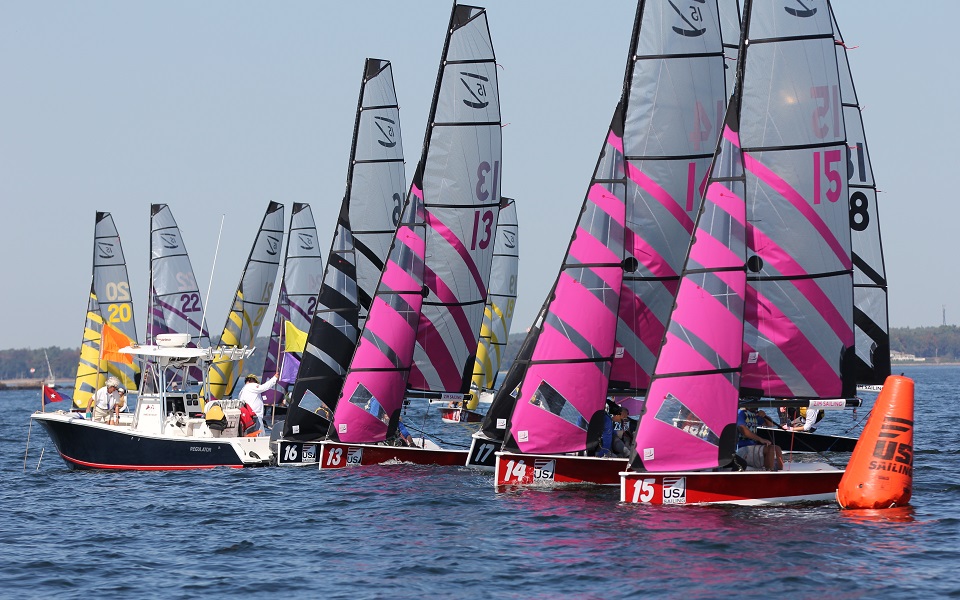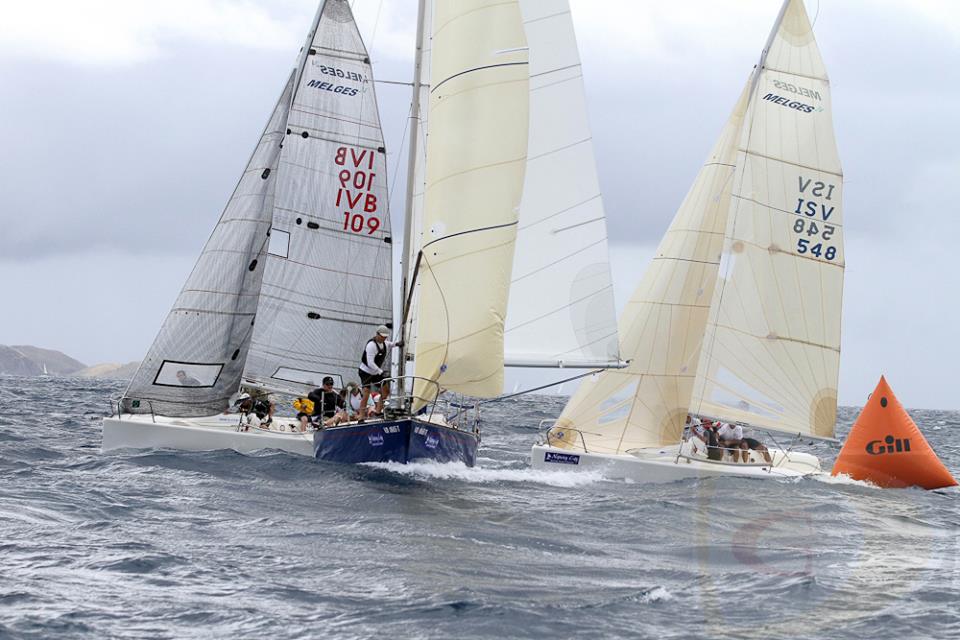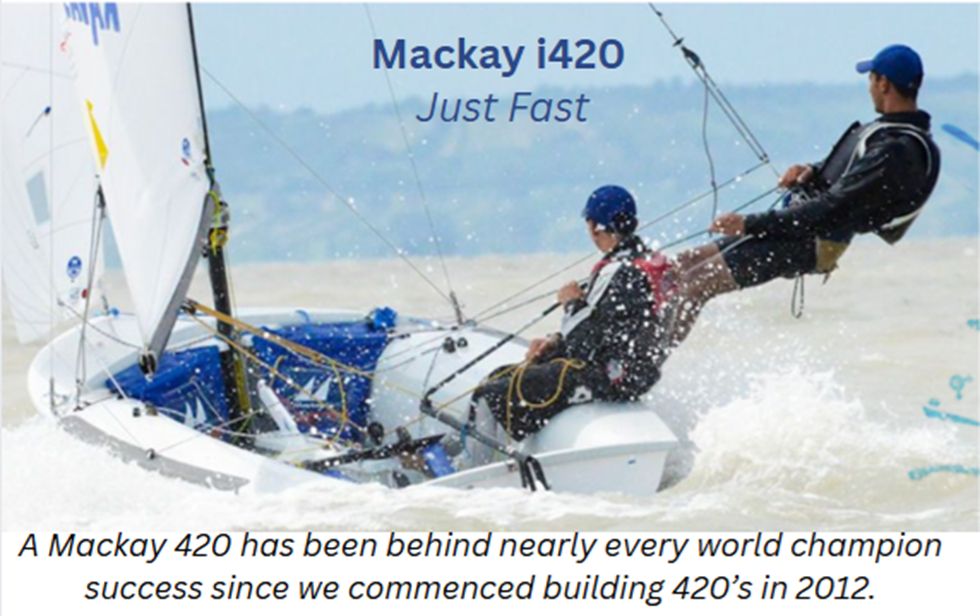Sail1Design would like to welcome our newest team member and sponsor, Whitecap Composites!
By Airwaves Writer Tyler Colvin
On a grey New England day I pulled around the corner of yet another non-descript warehouse building to discover a rack of hulls and plugs and an assortment of familiar bumper stickers. I had arrived at Whitecap Composites, in Peabody, Massachusetts, for a tour and to see what these guys were all about. Partners Ben Parker and Paul Zimmerman have created buzz about their little shop in recent years with their ability to turn out extremely high quality, durable boats for organizations and individuals.
Stepping through the door I was greeted by the familiar fiberglass and resin smell of a boat shop, reggaeton cutting through the hum of a pump and buzz of grinders. Ben came out to meet me with a smile and a handshake, very excited to show someone their operation. We walked through the assembly area, which consisted of boats in several stages of completion, and he explained the process that makes them unique from the slew of dinghy shops in the Northeast. “We take large boat construction and apply it to the dinghy. These are built like a real boat,” explained Ben, “everything about the construction process is repeatable and consistent.”
What Ben was referring to is the construction process they have been using since their shop opened back in 2011. In dinghy construction, there is usually a trade off between weight and durability. Fiberglass is laid up with resin by hand, cured, popped from the mold and put together. Not at Whitecap. Using structural fiberglass around a thin foam core combined with a vacuum bag infusion of resin, they are able to balance weight and stiffness, and are ensured a consistent product and create a bulletproof hull.
“Would you ever take a sledgehammer to one of your boats?” asked Ben, “well you can take one to ours.” He proceeded to tell me a recent story of some Kings Point guys who came up to see the shop and process, were asked the same question and then given a sledgehammer to test it out. Long story short, the sledgehammer lost.
The amount of pride that Ben and Paul put in their work is very apparent from their enthusiasm about the fleets they are building, new projects coming in to them and the thought of expanding. “We are unique in that we are responsive. We are available to our customers,” said Paul. “You see him and I? He is production, I am sales. If someone needs to ask a question on the phone, I cover the mouthpiece and ask him. Eliminates the need to go from department to department.”
Whitecap Composites has worked in conjunction with several college teams, one-design classes and individuals in the past four years. They have built 75 boats that are sitting on MIT’s docks, including the new Turbo FJ, which were purchased by both MIT and Northeastern University. Other schools are ordering from Whitecap as well, recently Christopher Newport University took delivery of 18 Turbo 420s. Eckerd is awaiting a shipment of FJs and 420s from Whitecap and Tufts has a new fleet of Larks in the works as well. Outside the college world they have also produced several other boats on a sub-contract basis, including the custom wakeless coach boats for Community Rowing in Boston and are working with the Comet class to revitalize.
Ben and Paul pride themselves on quality and the ability to accommodate their clients. “Our boats don’t come off the water during your season,” Ben commented, “we value quality over quantity.” Whether it is for a collegiate fleet or a custom build, they want you to feel involved in the process and help you get exactly what you want.
We would like again to give Whitecap Composites a warm welcome to the Sail1Design family as our newest team member. Feel free to stop over to their shop in Peabody to check them out, or just call Ben or Paul, they are sitting ten feet from each other, so if one doesn’t know the answer to your question, chances are the other does.
Blog
Meet the US Sailing Team Sperry Top-Sider – Caleb Paine
By Airwaves writer Martha Pitt
Approaching his 24th birthday this week, Caleb Paine is one of the bright young members of the US Sailing Team Sperry Top-Sider on the hunt to win a medal for the US Team at the Rio Games in 2016. Since 2010, he has been sailing the Finn in the ISAF Sailing World Cup circuit full time working towards his goal, and he has certainly been making strides towards that goal! Currently ranked 1st in the country and 5th in the world, Caleb’s notable finishes this year include 1st at Finn North Americans, 5th at Sailing World Cup Hyeres, and an impressive 7th place finish at the ISAF Sailing World Championship in Santander.
Caleb has been sailing his entire life, and starting racing in the Sabot at age 7 in San Diego. By the time he was 12 years old, he was 6 feet tall and weighed 145lbs – a bit too large for the Sabot! He then transitioned to the Laser Radial and later to the Laser Full Rig at 15, quickly becoming one of the top junior Laser sailors in the country. He also sailed on his high school team at Point Loma High School, and became captain his senior year. Around this same time, Caleb started sailing the Finn. After graduating high school with a dream of winning an Olympic gold medal, Caleb decided to put school on hold and pursue his goal. In the spring of 2009, he bought himself a Finn and began training and competing full time. He joined the US Sailing Team Sperry Top-Sider in 2011 and has since been climbing the World rankings in preparation toward his Olympic goal.
Read some more about Caleb, his campaign, and his journey below, and be sure to follow him at http://www.medalinrio.com/, and on Facebook at https://www.facebook.com/medalinrio.
And be sure to follow the US Sailing Team Sperry Top-Sider at http://ussailingteam.uberflip.com/h/!
S1D: When did you start sailing, and what kind of boats did you learn on?
CP: Sailing has always been a part of my life. My parents have pictures of me at 2 weeks old falling asleep in the gangway on my dad’s boat. He would suspend me in the backpack and it would swing around with the sea until I fell asleep. The first time I ever sailed on my own was in a Sabot at Mission Bay Yacht Club.
S1D: What got you into sailboat racing?
CP: I have always been competitive and once I realized I could combine that with sailing I started to race.
S1D: How long have you been sailing the Finn?
CP: I have been Finn sailing for 5 years now. I started in 2009 with my first event and first time traveling overseas being Kiel, followed by the world championships shortly after, I placed 56th.
S1D: Who are your favorite teams to sailing against?
CP: The British.
S1D: What is your game plan for the next 2 years leading up to Rio?
CP: To really refine my equipment and spend time sailing down in Rio. The conditions vary greatly from sailing in the bay to the conditions in the ocean. The Finns will be sailing in both so I’ll need lots of training time in each.
S1D: Which events are you most looking forward to in the next year?
CP: The Rio Test event in August and the Finn Gold Cup in New Zealand.
S1D: What advice would you give other sailors who are interested in Olympic sailing?
CP: It is an amazing journey where you meet great people and make lifelong friends. In terms of competition you couldn’t ask for anything more difficult, which I love!
S1D: What does it mean to you to be on the US Sailing Team?
CP: Being on the US Sailing Team Sperry Top-Sider means you are the best US sailor in your class. Being the best person at something amongst 319 million people is pretty sweet.
S1D: What are some of your favorite things about being on the team?
CP: Being a part of a team that succeeds together is a great feeling.
S1D: What has been the most challenging aspect about campaigning and/or your campaign?
CP: Money has always been an issue for me. It took me 5 years for me to get a new mast and boat made to my specifications.
S1D: How would you describe your relationship with other athletes on the team?
CP: I have known most of the athletes on the team for a while now and I would consider them all to be great sailors as well as people. I have a lot to learn from my fellow team members and look forward to working more with them the closer we get to Rio.
S1D: Who have been the most influential people in your sailing career?
CP: I would have to say my dad Doug Paine, who sailed singlehanded to Hawaii on a 25 foot boat.
S1D: What has been your favorite place to sail in international competition? Least favorite?
CP: San Francisco will always be my favorite, but a close second would be Santander where the past ISAF Worlds were held. Don’t have a least favorite, just a place I haven’t fully figured out.
S1D: Similarly, what has been your favorite place to travel to or visit?
CP: Tallinn, Estonia one must go to understand the beauty and culture of such a cool little place tucked away in the Northeast corner of Europe.
S1D: Do you have any rituals or superstitions relating to your sailing?
CP: Nope my fate is in my own hands.
S1D: Does your boat have a name?
CP: Yep, it’s a secret.
S1D: What do you like to do when you aren’t sailing the Finn, like for fun or to cross-train?
CP: I don’t know if you can consider it cross training but skeet and trap shooting.
S1D: If there was one thing that you would like the readers of this article to know about you, what would it be?
CP: I have always had the dream to sail in the Volvo Ocean Race.
S1D: If you were to reincarnate as an animal, what do you think it would be and why?
CP: An otter, they love the water, eat and play all day.
2015 Team Race Midwinters Preview
By Airwaves Writer Clinton Hayes
For almost 2 decades team racing enthusiasts made the annual pilgrimage to Florida over New Years for Vanguard 15 Midwinters. That event and its host, usually Jensen Beach, were special in so many ways, but for better or for worse, it is no more. The current climate of team racing seems to demand provided boat events, (see recent our article on Provided Boats) so in steps Eckerd College. Eckerd now has the 2nd event on the growing dinghy team racing circuit, the other being the Free State Team Race in Annapolis, MD.
If you were lucky enough to attend a V15 midwinters you undoubtedly had a great time. Tight competitive racing during the day gives way to often rowdy, nighttime fun. Whatever your expectations are for this event, Eckerd has you covered. As a Nationally ranked college team, their boats and venue are top notch. Sailing takes place just off Eckerd’s campus beach were you’ll sit between races. Being in a protected bay, the water is generally flat with a little chop if the wind picks up. Manatee sightings are common near the mangroves that surround parts of the bay and line the narrow waterway you sail out of between the boathouse and the racing area. Racing will be in Eckerd’s fleet of FJs as well as Zim 15s, the boat currently sailed at the US Team Racing Championships. Expect coaches Kevin and Zack to have everything in order for a nice efficient event. As long as the wind cooperates, which it usually does during the winter in Florida, there will be plenty of racing.
For Competitors missing the Four Fish Inn in Jensen Beach(does that bring back some memories!) the regatta hotel for this event, Postcard Inn, seems like a worthy substitute. Its location right on the Gulf of Mexico on St.Pete Beach will provide no shortage of fun. They are hosting a full New Year’s Eve party with a live band and bon fire on the beach. How else would you want to ring in the New Year with all your best sailing friends? The next night they are hosting a dinner for all regatta competitors. I’m told if enough people register and stay at the hotel they are going to do a pig roast on the beach!
There are a number of teams already registered. A couple of college teams looking to get a jump-start on the team racing season and some veterans coming back for more. This 1st annual event is not to be missed. Make your plans now to drive or fly into the Tampa area. If you need help finding a team or are looking for someone to fill out a team post on the Facebook event page, 2015 Midwinter Team Race
https://www.facebook.com/events/1557696367794320/?ref=br_tf . I guarantee you’ll make many new friends and great memories, just as it’s always been.
Rounding the Windward and Offset Mark with a Symmetrical Spinnaker
By Andrew Kerr
This article takes a look at the important elements of rounding the windward mark and offset mark with some key elements in mind for teams using a symmetrical spinnakers, with a few exceptions the vast majority of the elements that we explore apply to Asymmetric boats well. In this article we will look at the boat handling skills a team needs to practice & develop, in a future article we will look at tactics we can use at these marks. Even if your team does not anticipate sailing with an offset mark a great deal, the vast majority of the information below will help your team be smoother at the windward mark rounding.
Approaching the windward mark
- Hike hard coming in to the mark so the boat is flat and fast!
- When the bow person sets the pole, hike especially hard and if possible pull the pole topping lift up from the hiking position
- If it is a long sail to the offset mark then delay setting the pole until you have rounded the windward mark to minimize disruption – particularly in heavy or very light conditions – the caveat to this is if you can set the spinnaker between the marks.
- Ease the vang a couple of inches (be sure to re-cleat it!) to the preset downwind mark to help preset the mainsail leech tension for downwind sailing and also to help the boat bear away by opening the mainsail leech.
- The headsail trimmer really wants to focus on perfect trim of the sail and not be distracted – particularly important if sailing in dirty air from another boat or getting lifted into the mark requiring the Jib to be eased for max speed.
- Top skippers keep the boat going fast at all times – keep the boat rolling and be sure not to pinch too much , have the crew keep calling out waves and puffs all the way into the mark so you can be anticipating the elements. This is a chance to extend on boats behind you and catch boats ahead, boat length by boat length.
- Don’t pinch – if on a tight lay line to the mark – take the mark out of the picture and go fast, the lift off the foils will very often give the team the added pointing it needs. It’s all too common for a team to pinch too much initially and not make the mark anyway.
Between the windward mark and the offset mark – sail fast!!
As a coach I observe and video tape a lot of races and one of the common threads is the gains and losses for teams when sailing between the marks – particularly in the extremes of conditions – very light or heavy air.
Key elements for sailing fast between the marks:
- Trimming the sails well – keep the headsail tell tales flowing – this does mean easing it and when it is time to set on smaller boats the trimmer can grab the clew of the sail and pull it inboard to facilitate the spinnaker going up smoothly and not getting trapped between the leech of the Genoa and the boom and helps the foot of the sail pre feed easier.
- On boats with skirt lines attached to the foot of the genoa (like a J24) the bow person skirts the foot of the sail inboard of the lifelines to help with the pre feed of the spinnaker foot.
- Particularly when it is breezy – sail the boat flat and not allowing excessive heel.
- When it is light – minimizing movement and being smooth will maintain momentum and speed.
- Determine how much pre feed on the spinnaker foot you want – if it is light then gently feed the foot out so that it doesn’t disrupt the headsail, if it is breezy then you may want to delay until the boat is around the offset mark and flat and pointed downwind so that the foot of the sail does not get out of control. In medium conditions you likely will be able to pre feed most of the way but be careful of the sail touching the offset mark or a leeward boat.
- Take an opportunity in light/ moderate conditions to ease the Cunningham (if on at all) all the way off and the outhaul to the eased setting for downwind sailing.
- The bow person can point to the offset mark to help the skipper gauge where it is as well as the middle looking to leeward helping keep track of it.
Setting the spinnaker between the marks
With the wind veering to the right and your team getting lifted on starboard tack going into the mark there may be an opportunity to set between the marks, here is a check list for this:
- Make sure you get a good visual on where the offset mark is – it is easy to lose sight of it when pre feeding the spinnaker, the bow person ( as mentioned earlier) or trimmer or tactician can help point out where it is and if possible the skipper needs to get themselves in a good place for them to see it. One helpful trick is if you are approaching the windward mark on port tack is to have the skipper take a quick glance at the angle and distance of the offset mark in relationship to the windward mark so that if they have to tack at the windward mark they have a good idea where the heading of the bow has to go immediately once the tack is completed.
- If there is a boat to leeward of you and slightly ahead of you (preventing you from bearing away)- head high and then bear away and go behind them – this will give you the ability to set and get inside and be able to jibe at the offset – you don’t want to be pinned outside them. In this situation the likelihood is that the team will need to jibe to port quickly with a right shift to get in phase with the wind – current and wind shadows and other strategic needs notwithstanding.
- Be sure that the leeward twing is all the way off and the windward twing all the way on.
- Caution – if the twing line is too long it can scoop the offset mark – has them long enough but not too long!
- Pull the guy back so that the pole is at least 9 inches to almost a foot off the forestay – the guy will stretch this much at least on a reach when the spinnaker fills.
- Luff the spinnaker if necessary to get the spinnaker halyard all the way to the top and then sheet in.
- If breezy – delay pulling the Jib down to keep the weight on the high side until the boat has flattened out. In this instance if you have the spinnaker and Genoa up at the same time be sure to keep the Jib sheet well eased to allow the spinnaker to fly – if it is slightly over trimmed the sails forms a vacuum of stall and collapses the spinnaker.
- When bearing off at the offset mark ease the spinnaker sheet first and that will make squaring the pole much faster and easier, sounds simple but a lot of teams have difficulty squaring the boat back smoothly – particularly on bigger boats or when it is windier.
Rounding the offset Mark
Look to round the mark tactically if at all possible – aim half to three quarters of a length to windward of the mark and then smoothly turn down while giving the main a good and fluid ease, the goal is to minimize the loss of the turn, very often teams button hook turn around the mark and end up losing a lot of speed and also end up way wide with other teams getting inside them.
- Backstay off as soon as you can and when possible organize the Main traveler so it is centered, assuming the mainsheet is long enough.
- As soon as you possibly can make sure you have a crew member looking back for velocity and the angles of other boats – gets this dialogue going as fast as possible – this is critical.
Hoisting the spinnaker in light air at the offset mark
Be sure to keep the pole forward as the apparent wind is well forward – slightly over trim the spinnaker sheet and when the boat speed and apparent wind angles start to get closer together then slowly start to bring the pole aft. Pulling the pole aft prematurely in light air is a common mistake and will collapse the spinnaker every time, watch for this, particularly with a new trimmer or fill in crew member.
It’s all in the details
- Put a series of marks ( or with tape on the solid part if you have a solid vang) on the vang so you know how much to ease it to set the mainsail
- Leech tension with the top baton parallel, or more open if in planning mode to the boom once you are downwind
- Mark the topping lift so that the pole is set to the correct height
- Mark the spinnaker halyard so you know when it is fully hoisted
- Do a practice bear away set and mark the spinnaker sheet & cleat it when the pole is squared and the sail full. This pre set mark will allow you to focus on pulling back the guy on the set and free a hand up with the spinnaker filling nicely.
Conclusion
All the above is well worth practicing – there are good gains to be had here for your team and over the course of a series the points gained will add up.
In a future article we will examine some tactics your team can use at the windward and offset mark.
Good sailing!
Are Provided Boats Really The Answer?
By Airwaves writer John Storck
In the ongoing debate of how to improve the state of our beloved sport, there is one argument that keeps coming up- provided boats. The argument typically comes from someone who is heavily involved with the keelboat team racing circuit, which is sailed at high-end yacht clubs throughout the country and abroad in provided boats. The argument is that we need more provided boats since people obviously aren’t getting in line to buy boats these days.
Now don’t get me wrong, I love the keelboat team racing scene, and it would not exist without provided boats. Match Racing is another aspect of our sport which needs provided boats to be successful. But I think we have to be careful in looking at the concept of provided-boats as a solution.
For starters, provided-boat regattas are exclusive by their very nature. There are a limited number of seats. If there is a 12 team cap on registration, and a 13th team wants to come, that’s a whole group of sailors that will be sitting on their couch instead. This doesn’t help the growth of our sport.
Secondly, the provided boat concept does not promote boat ownership. If there are more and more provided-boat events, there are just more sailors convinced they never have to own a boat. However, due to the limited seats, that same sailor is likely to only be sailing half the regattas that they would in a boat-ownership situation. Boat ownership is good for more than just the owner as well. With no registration limits, there are far more seats to fill with crew as well. And lastly, the provided-boats concept is really tough on the boat-building industry, which we all should want to be thriving if we love sailing.
Finally, there is the problem of who can actually afford these fleets of provided boats. In reality, there are only a few high-end yacht clubs around the country that can do so. And if you want to regularly compete in these events (and have your regatta fees at least partially covered), then you better become a member at one of those clubs. Once you do so, get in line, because there are a few long email lists that will show you how many of your fellow members want to go to the same events. At the same time, you are probably going to pass on becoming a member at your local club to save money, making it less likely for that small local club to be able to support this new world of provided-boat sailing.
I recently heard an idea out of a small club that might be a better solution. There is one active active one-design fleet in their area. The board at this club is trying to get the money together to buy one boat of that type. They would then allow for new members to pay a low annual fee to be able to use that boat. The catch being that a member could only be in that program for a season or two. Not every member is going to go out and buy a boat after that experience, but chances are good that a few might. And if that happens, then they have successfully grown their local fleet. This is just one example, and I am sure there are more ways to help our sport grow.
Again, I really want to stress that I love keelboat team racing, and there is no way that aspect of our sport thrives without provided boats. However, asking for more and more of it won’t help sailing grow due to it’s exclusive nature.
Team Race Midwinters 2015 Notice of Race!
If you are bummed that the V-15 midwinters are dead, or if you never sailed the V-15 midwinters because you don’t have a boat, then come sail the first ever open Team Race hosted by Eckerd College. We are hosting in the hopes of filling in the gap the V-15 Midwinters will leave in its absence. Boats are provided, the dates have been setup not to conflict with Orange Bowl and entry is cheap. Flying to Tampa or Sarasota is a piece of cake and we have partnered with the Post Card Inn. They have a hotel right on the beach and are excited to have us join in on their New Year’s Eve festivities. We will have an included regatta dinner at the Post Card Inn and they are giving a special regatta rate so you can safely stay right where the off water fun is happening. Lastly, the event will include 6 Zim 15s. This will allow us to take more entries and allow competitors to sail the boat used at the Hinman TR.
Here is the link to the event: http://www.regattanetwork.com/event/9268#_home
and FB page: https://www.facebook.com/events/1557696367794320/?ref_dashboard_filter=upcoming
